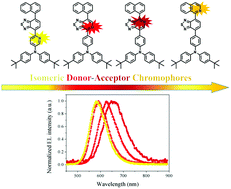Rational design of high efficiency green to deep red/near-infrared emitting materials based on isomeric donor–acceptor chromophores†
Abstract
A family of compounds TPA-BT-Q, TPA-pyT-N-naph, TPA-N-pyT-naph, and DPA-py-N-BT-naph with an isomeric donor–acceptor conjugation framework were designed and synthesized, and their structure–property relationships, theoretical calculations, and photophysical and electrochemical characteristics were investigated. These isomeric chromophores showed significantly different photophysical properties. Emission wavelengths spanning from the green to near-infrared region were observed in different solvents with high photoluminescence quantum yields, exceeding 90% in low polarity solvents and 44–88% in blend films. Organic light-emitting devices (OLEDs) displayed a strong electroluminescence with emission peaks at 592, 660, 630, and 580 nm; maximum current efficiencies of 7.92, 2.93, 3.56, and 15.37 cd A−1; maximum power efficiencies of 4.21, 1.56, 1.81, and 8.24 lm W−1; and maximum external quantum efficiencies of 3.15%, 2.75%, 2.66%, and 5.33% for TPA-BT-Q, TPA-pyT-N-naph, TPA-N-pyT-naph, and DPA-py-N-BT-naph doped OLEDs, respectively.



 Please wait while we load your content...
Please wait while we load your content...